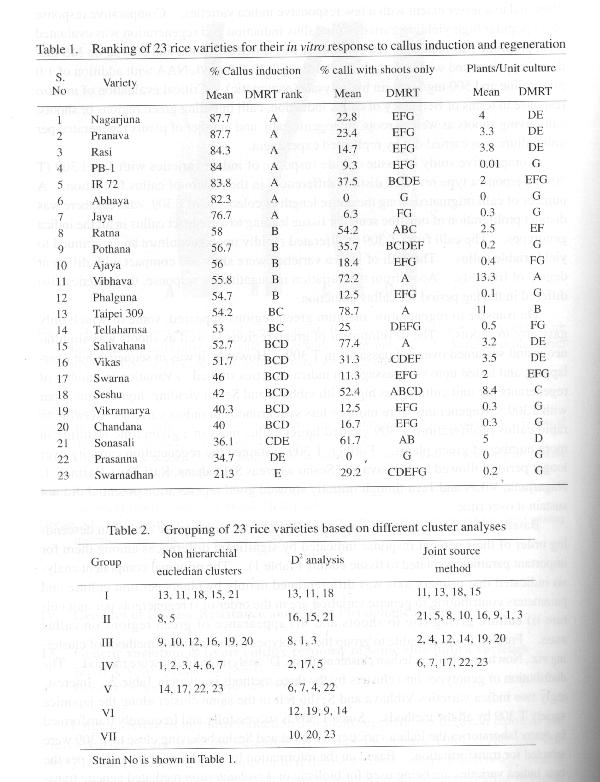K.B.R.S. VISARADA and N.P. SARMA
Directorate of Rice Research, Hyderabad 500030, India
Large differences in callus induction and plant regeneration
between japonica and indica varieties are well documented (Abe and Futsuhara
1984, 1986 and Jain 1997). Japonicas appear to be superior in response
to tissue culture which is why most of the advances in tissue culture and
genetic transformation are demonstrated using japonicas
often and to a lesser extent with a few responsive indica
varieties. Comparative response of 23 popular high yielding varieties for
callus induction and regeneration was evaluated on appropriate MS medium.
Regeneration was tested at 30-40d and 60-70d on MS medium supplemented
with 2.5 mg/L BAP, 1.0 mg/L K, 0.5 mgfL NAA with addition of 1.0 g/L proline
and 500 mg/L casein hydrolysate (enzymatic). Critical evaluation of in
vitro response in terms of frequency of callus induction, calli initiating
green regions or shoots, calli giving shoots as well as roots, rhizogenic
calli and number of plants regenerated per unit culture was carried out
by replicated experiment.
Comparative study of tissue culture response of indica varieties
with Tapei 309 (T 309), ajaponica type revealed distinct differences in
the pattern of callus formation. A number of calli originated along the
entire length of coleoptile in T 309, whereas there was distinct proliferation
of only the scutellar tissue leading to a compact callus in all the indica
genotypes. The calli from T 309 proliferated rapidly upon subculture and
continued to yield friable callus. The calli of indica varieties were slow
and compact with different degree of friability. Apart from the variation
in quantitative response, the varieties also differed in the lag period
for callus induction.
On transfer to regeneration medium green regions appeared,
some of which only gave rise to shoots. The development of green regions
as well as shoots was simultaneous and sustained over 3-4 passages in T
309. However, it was in sequence but overlapping and lasted upto two passages
in indica varieties studied. Variation in number of regenerants per unit
culture was high with vibhava and Seshu yielding highest and at par with
T309. Regenerants were more or less synchronous in indica varieties. Owing
to rapid callus proliferation, T 309 yielded larger callus mass in a given
time resulting in more number of green plants. Further, T 309 sustained
the regeneration capacity over longer period followed by Vibhava and Seshu
whereas Salivahana, Rasi, Pusa Basmati- 1, Nagarjuna, Vikas and Jaya though
initially showed good regeneration potential did not sustain it over time.
Based on Duncanís multiple range test (DMRT) the varieties
are ranked in descending order of their percent response indicated by significant
differences among them for important parameters related to tissue culture
(Table 1). The principal component analysis indicated that primary axis
was differentiated mainly by plants per unit culture and parameters contributing
to genetic variation are in the order of i) regenerants per unit culture
ii) culture giving rise to shoots and iii) appearance of green regions
on callus mass. Further, it was possible to group the genotypes following
three methods of clustering viz., Non hierarchial eucledian cluster analysis,
D2 analysis and Joint score method. The distribution of genotypes into
clusters by the three methods is given in Table 2. Interestingly two indica
varieties Vibhava and Seshu fell in the same cluster along the japonica
variety T 309 by all the methods. Since T 309 is successfully and frequently
transformed by many laboratories the indica varieties, Vibhava and Seshu
behaving close to T 309 were selected for transformation. Based on the
information by clustering of the genotypes the two indica varieties are
being used for biolistic or Agrobacterium mediated genetic transformation.
|

|
Abe, 1.
|
and Y. Futsuhara, 1984. Varietal differences in plant regeneration
from root callus tissues of rice. Japan.
|
|
Abe, T
|
andY. Futsuhara, 1986. Genotypic variability for callus
formation and plant regeneration in rice (Oryza
|